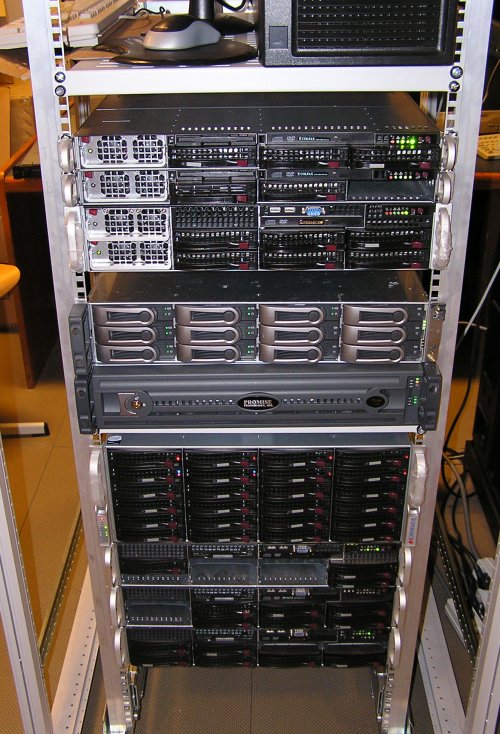The Best Server CPUs Compared, Part 1
by Johan De Gelas on December 22, 2008 10:00 PM EST- Posted in
- IT Computing
Benchmark Configuration
Here is the list of the different configurations. All servers have been flashed to the latest BIOS at this moment.

Inside our lab
Quad Xeon Server 1: Supermicro SC818TQ-1000 1U Chassis
2x - 4 x Intel Xeon E7330 at 2.4GHz and X7350 at 2.93GHz
Supermicro X7QCE board
16GB (8 x 2GB) Samsung M395T5750EZ4 667MHz 5-5-5-18
NIC: Dual Intel PRO/1000 Server NIC
PSU: Supermicro 1000W w/PFC (Model PWS-1K01-1R)
Dual Xeon Server 2: Intel "Stoakley platform" server
Supermicro X7DWE+/X7DWN+ board
1 or 2 Xeon E5472 at 3GHz, Xeon L5430 at 2.66GHz, and Xeon E5470 at 3.33GHz
16GB (8x 2GB) Samsung M395T5750EZ4 667MHz 5-5-5-18
NIC: Dual Intel PRO/1000 Server NIC
PSU: Ablecom PWS-702A-1R 700W
Dual and Quad Opteron Server: Supermicro SC828TQ-R1200LPB 2U Chassis
1, 2 or 4 AMD Opteron 8356 series at 2.3GHz
1, 2 or 4 AMD Opteron 8384 series at 2.7GHz
Supermicro H8QMi-2+ board
16GB (8x 2GB) Avant AVF7256R61E6800FB-MTEP 800MHz 6-5-5-18
NIC: Dual Intel PRO/1000 Server NIC
PSU: Supermicro 1200W w/PFC (Model PWS-1K22-1R)
Client Configuration: Intel Core 2 Quad Q6600
Foxconn P35AX-S
4GB (2x 2GB) Kingston 667MHz DDR-2
NIC: Intel Pro/1000










29 Comments
View All Comments
Bruce Herndon - Tuesday, December 23, 2008 - link
I'm surprised by your comments. You claim that VMmark is a CPU/memory-centric benchmark. If I look at the raw data in the VMmark disclosure for Dell's R905 score of 20.35 @ 14 tiles, I see that the benchmark is driving 250-300 MB/s of disk IO across several HBAs and storage LUNs. This characteristic scales with the various systems mentioned in the article.As a designer of VMmark, I happen to know that both storage bandwidth (for the fileserver) and latency (for mail and database)are critical to acheiving good VMmark scores. Furthermore, the webserver drives substantial network IO. The only purely CPU-centric component to VMmark is the javaserver. Overall, the benchmark does exercise the entire virtualization solution - hypervisor, CPU, memory, disk, and network.
cdillon - Tuesday, December 23, 2008 - link
While SAS and Infiniband share some connectors and obtain similar data rates, they are incompatible technologies with two different purposes. Infiniband can be used for disk shelf connections, but it is less common and definitely not the case here. You should not call the connection between the Adaptec 5805 controller and the disk shelf an "Infiniband connection", even if it is using Infiniband connectors and cables, it is simply an SAS connection.JohanAnandtech - Tuesday, December 23, 2008 - link
Well, the physical layer is Infiniband, the used protocol is SCSI. I can understand calling it an "infiniband connection" maybe confusing, but the cable is an infiniband cable.shank15217 - Friday, December 26, 2008 - link
Anand, I think the above poster is right. The Adaptec RAID 5805 uses SFF-8087 connectors but the protocol is SSP (Serial SCSI Protocol). Infiniband is a physical layer protocol that shares the same connector as SAS but they are not the same. Nothing in the Adaptec RAID 5805 spec mentions Infiniband as a supported protocol.http://www.adaptec.com/en-US/products/Controllers/...">http://www.adaptec.com/en-US/products/C...ers/Hard...
niva - Tuesday, December 23, 2008 - link
I'm not sure you can run your same ol benchmark for rendering, and I'd really like more insight into what you guys are rendering and if it's indeed using all 16/24(six core 4 point system)/32(hyperthreading) cores on the system.What renderer, what scene, details details...
These chips get gobbled up by render farms and this is indeed where they can really flex their muscles to the fullest.
JohanAnandtech - Tuesday, December 23, 2008 - link
Just click on the link under "we have performed so many times before" :-)akinneyww - Tuesday, December 23, 2008 - link
I read DailyTech and anandtech.com to keep up with the latest in IT. I appreciate the thought that has gone into putting together this article. I would like to see more articles like this one.Jammrock - Tuesday, December 23, 2008 - link
The VMware results shocked me the most. I know AMD has been working hard on the virtualization sector and it looks like their work has paid off.classy - Tuesday, December 23, 2008 - link
With the rapid increase of virtualization, AMD is looking really strong. We have begun using 3.5 Vmware and are expanding the use of it. Virtualization is truly becoming a big thing in server choice.